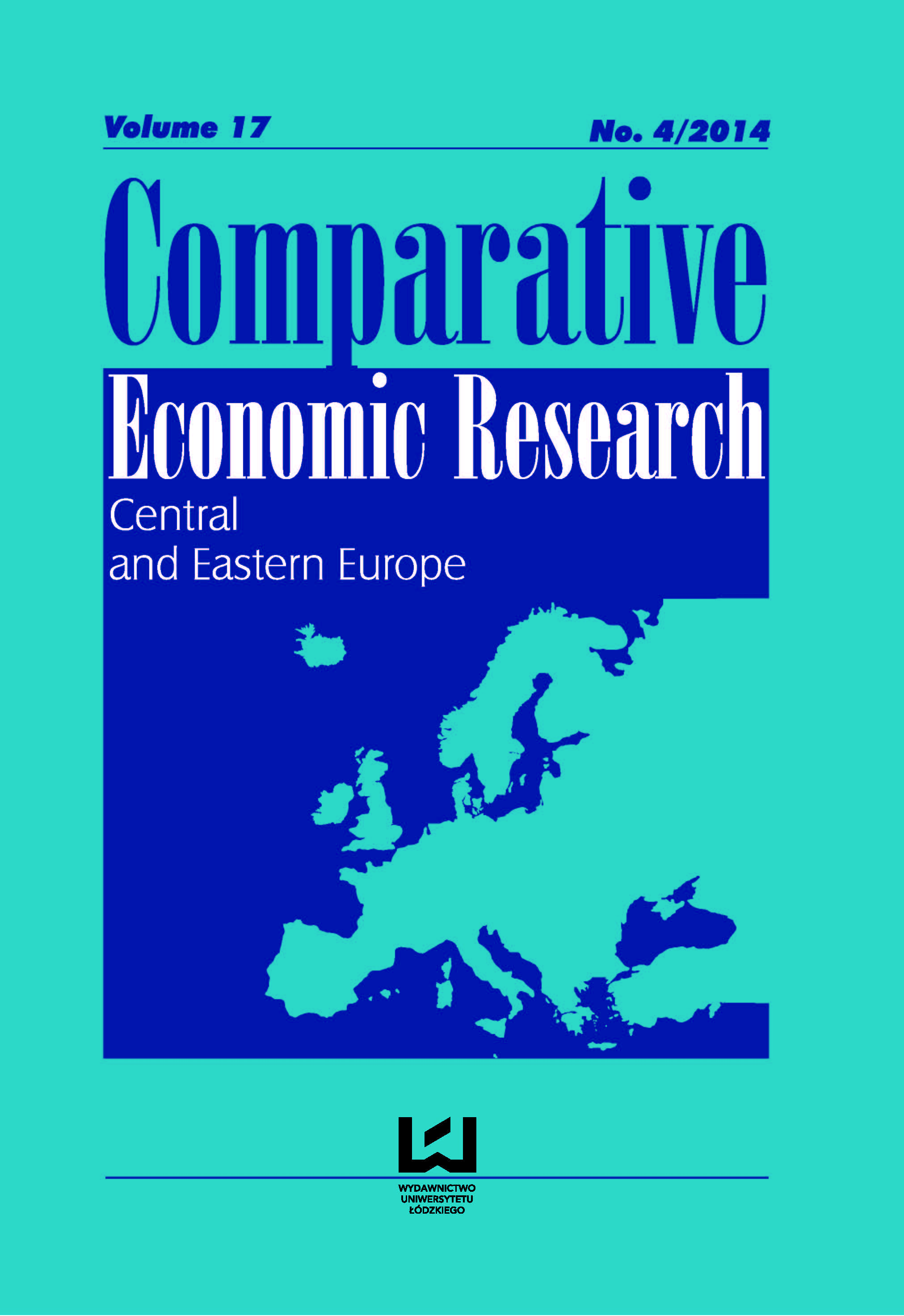An Empirical Study Of Productivity Growth In EU28 - Spatial Panel Analysis
DOI:
https://doi.org/10.2478/cer-2014-0040Keywords:
spatial panel model, spatial econometrics, productivity growthAbstract
This paper investigates the spatial process of productivity growth in the European Union on the foundations of the theory of New Economic Geography. The proposed model is based on the study of NUTS 2 regions and takes into consideration a spatial weights matrix in order to better describe the structure of spatial dependence between EU regions. Furthermore, our paper attempts to investigate the applicability of some new approaches to spatial modelling including parameterization of the spatial weights matrix. Our study presents an application of the spatial panel model with fixed effects to Fingleton’s theoretical framework. We suggest that the applied approach constitutes an innovation to spatial econometric studies providing additional information hence, a deeper analysis of the investigated problem.
Downloads
References
Anselin L. (1988), Spatial Econometrics: Methods and Models, Kluwer, Dordrecht.
Google Scholar
Anselin L., Bera A.K. (1998), Spatial dependence in linear regression models with an introduction to spatial econometrics, [in:] Ullah A., Giles D. (ed.). Handbook of Applied Economic Statistics, Marcel Dekker, New York.
Google Scholar
Bernat G. A. (1996), Does Manufacturing Matter. A Spatial Econometric View of Kaldor’s Laws, Journal of Regional Science, 36, 463-477.
Google Scholar
Burridge, P., Gordon I. (1981), Unemployment in the British Metropolitan Labour Areas, Oxford Economic Papers, 33(2), 274-297.
Google Scholar
Combes P. P., Lafourcade M. (2001), Transportation costs decline and regional inequalities: evidence from France, CEPR DP 2894.
Google Scholar
Combes P. P., Lafourcade M. (2004), Trade costs and regional disparities in a model of economic geography: structural estimations and predictions for France, http://www.enpc.fr/ceras/combes/
Google Scholar
Combes P. P., Overman H. (2003), The spatial distribution of economic activity in the EU, CEPR DP 3999.
Google Scholar
Corrado L., Fingleton B. (2012), Where is the economics in spatial econometrics?, Journal of Regional Science, 52 (2): 210-39. doi: 10.1111/j.1467-9787.2011.00726.x
Google Scholar
EUROSTAT (2002), European Regional Statistics. Reference guide, European Communities, Luxembourg.
Google Scholar
Fingleton B. (2000), Spatial econometrics, economic geography, dynamics and equilibrium: a third way? Environment and Planning A, 32, 1481-1498.
Google Scholar
Fingleton B. (2001), Equilibrium and economic growth: spatial econometric models and simulations, Journal of Regional Science, 41, 117-147.
Google Scholar
Fingleton B. (2003), Increasing returns: evidence from local wage rates in Great Britain. Oxford Economic Papers, 55, 716-739.
Google Scholar
Fingleton B. (2004a), Regional economic growth and convergence: insights from a spatial econometric perspective, [in:] Anselin L., Florax R., Rey S. (ed.) Advances in Spatial Econometrics, Springer- Verlag, Berlin, 397-432.
Google Scholar
Fingleton B. (2004b), Some alternative geo-economics for Europe's regions, Journal of Economic Geography, 4, 389-420.
Google Scholar
Fingleton B. (2006), The new economic geography versus urban economics: an evaluation using local wage rates in Great Britain, Oxford Econ Pap., 58, 501-530.
Google Scholar
Fingleton B., Lopez-Bazo E. (2006), Empirical growth models with spatial effects, Papers in Regional Science, 85(2), 177-198. doi: 10.1111/j.1435-5957.2006.00074.X
Google Scholar
Fingleton B. (2007), A multi-equation spatial econometric model, with application to EU manufacturing productivity growth. Journal of Geographical Systems, Springer, 9(2), 119-144. doi: 10.1007/s10109-006-0038-5
Google Scholar
Fingleton B., McCann P. (2007), Sinking the iceberg? On the treatment of transport costs in new economic geography, [in:] Fingleton B. (ed.) New directions in economic geography. Edward Elgar, Cheltenham, 168-203.
Google Scholar
Fingleton B., McCombie J. S. L. (1998), Increasing returns and economic growth: Some evidence for manufacturing from the European Union regions, Oxford Economic Papers, 50, 89-105.
Google Scholar
Fischer, M.M., Scherngell T., Jansenberger E. (2006), The Geography of Knowledge Spillovers Between High-Technology Firms in Europe: Evidence from a Spatial Interaction Modelling Perspective, Geographical Analysis, 38(3), 288-309. doi: 10.1111/j.1538-4632.2006.00687.X
Google Scholar
Fischer M.M., Scherngell T., Reismann M. (2009), Knowledge Spillovers and Total Factor Productivity: Evidence Using a Spatial Panel Data Model, Geographical Analysis, 41(2), 204-220. doi: 10.1111/j.1538-4632.2009.00752.x
Google Scholar
Fujita M., Krugman P., Venables A. (1999), The Spatial Economy: Cities, Regions, and International Trade, Cambridge MA.
Google Scholar
Kakamu K. (2005), Bayesian Estimation of a Distance Functional Weight Matrix Model, Economics Bulletin, 3(57), 1-6.
Google Scholar
Kaldor N. (1957), A Model of Economic Growth, Economic Journal, 67, 591-624.
Google Scholar
Olejnik A. (2008), Using the spatial autoregressively distributed lag model in assessing the regional convergence of per-capita income in the EU25, Papers in Regional Science, Wiley, 87/3.
Google Scholar
Olejnik A. (2012), Wielowymiarowe autoregresyjne modele przestrzenne, [in:] Ekonometria przestrzenna II, Modele zaawansowane, (ed.) Suchecki B., C.H. Beck, Warszawa.
Google Scholar
Redding S., Venables A. J. (2004), Economic geography and international inequality, Journal of International Economics., 62, 53-82.
Google Scholar
Vega S.H., Elhorst J.P. (2013), On spatial econometric models, spillover effects, and W, ERSA working papers, http://www-sre.wu.ac.at/ersa/ersaconfs/ersa13/ERSA2013_paper_00222.pdf
Google Scholar
Verdoorn P.J. (1949), Fattori che Regolano lo Sviluppo della Produttivita del Lavoro, L’Industria, 1, 3-10.
Google Scholar
Downloads
Published
How to Cite
Issue
Section
License

This work is licensed under a Creative Commons Attribution-NonCommercial-NoDerivatives 4.0 International License.











